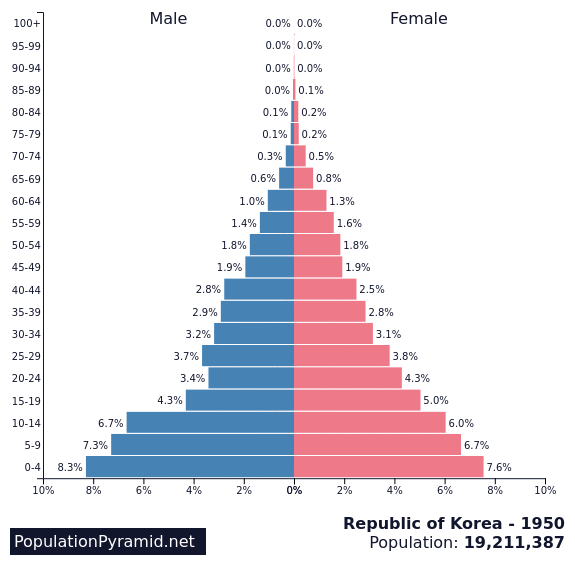Population Changes in South Korea
Population Changes in South Korea
South Korea’s birth rate has fallen for the first time in its history. As a high-income country, South Korea is battling an ageing population and low birth-rates.
An ageing population is when more people than ever live longer, often with more complex medical conditions. An ageing population increases the dependency ratio and means that the government has to pay more in benefits to people who often do not have the ability to pump money back into the economy.
The latest census (a count of all people and households) figures indicate South Korea’s total population stood at 51,829,023 at the end of December 2020. This is a reduction of 20,838 from the previous year.
Over the previous decade, South Korea’s population had increased every year, although that growth rate had decreased by 1.49% in 2010 to 0.05% by 2019.
During 2020 the country recorded 275,815 births in 2020, compared with 307,764 deaths.
If current trends persist, the government predicts South Korea’s population will drop to 39 million by 2067, when more than 46% of the population will be aged over 64.
Demographic transition
The animation below shows changes in South Korea’s population structure between 1950 and 2019. The animation clearly shows an increase in life expectancy (more people living to an older age) and a decrease in the proportion of younger people (as the birth rate decreases).
South Korea is undergoing an extreme, rapid example of what demographers (people who study population) call ‘demographic transition’. This is a period of population growth, decline and eventual stabilisation that occurs as countries get richer. For South Korea, this means both a large, rapidly ageing population and a low marriage and birth rate that don’t adequately replace the dying generations.
The demographic transition model attempts to show the population changes a country experiences as it develops.
In later stages of the demographic transition, health care improvements generally lead to a population with an extended life expectancy. That is exactly what is happening in South Korea, where life expectancy has increased rapidly in the second half of the 20th Century amid industrialisation.
In the first half of the 1950s, life expectancy was just shorter than 42 years on average (37 for men, 47 for women). Today, the numbers look radically different. South Korea now has one of the world’s highest life expectancies – ranked twelfth highest for 2015-2020, equal with Iceland. The average baby born in South Korea can now expect to live to 82 years (specifically 79 for men, and 85 for women).
In contrast, the global average is 72 years (nearly 70 for men, 74 for women).
In 1950, less than 3% of the population were aged 65 and over. Today, that number is at 15%. By the mid-2060s, the UN forecasts the percentage of those older than 65s will peak at more than 40%. The numbers paint a picture of a very aged society.
And with low birth rates, fewer marriages and longer lives, the trends combine to create a South Korean population that is actually ageing faster than any other developed country.
Why is South Korea’s population in decline?
South Korea has the lowest fertility rate in the world.
The average South Korean woman has just 1.1 children, lower than any other country. (For contrast, the global average is around 2.5 children.) This rate has been declining steadily: between the early 1950s and today, the fertility rate in South Korea dropped from 5.6 to 1.1 children per woman.
One reason for this is because, in South Korea, women struggle to achieve a balance between work and other life demands.
It has been suggested there is increasing opposition among South Korean women to conform to traditions of raising children and caring for ageing in-laws while husbands work.
South Korean women aren’t simply choosing to have fewer children – some are opting to forego romantic relationships entirely. An increasing number are choosing never to marry at all, turning their backs on legal partnerships – and even casual relationships – in favour of having independent lives and careers in what can still be a sexist society despite economic advances.
Soaring house prices are another major issue. Rapidly rising property prices mean a greater proportion of income is spent on mortgages. Also, young couples are put off having children because they are expensive to raise.
What issues are associated with a declining, ageing population?
Apart from increased pressure on public spending as demand for healthcare systems and pensions rise, a declining youth population also leads to labour shortages that directly impact the economy.
What is South Korea doing to address the issue of a declining, ageing population?
Like Japan, which also has a declining population, the government is under pressure to address the long-term issues caused by a rapidly ageing society.
The South Korean government recently announced initiatives to encourage couples to have bigger families, including a one-off payment of 1m won (£675) for pregnant women and monthly cash allowances for children aged under 12 months.
However, critics say the measures do little to tackle much bigger financial obstacles to having more children, such as high education and housing costs.




Leave a Reply
Want to join the discussion?Feel free to contribute!